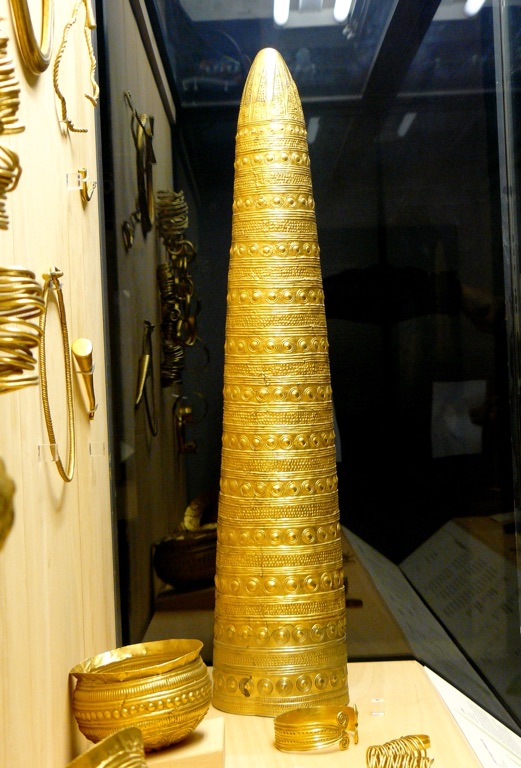The Avanton Gold Cone is a late Bronze Age artifact, remarkable for its craftsmanship and mystery. Discovered in Avanton, France, this cone is one of several known “Golden Hats” used in Central Europe during the Bronze Age. Made of thin gold leaf, it is intricately decorated with symbols whose meanings have been lost to time….
Urnfield culture
The Urnfield culture, flourishing during the Late Bronze Age from around 1300 to 750 BC, represents a significant period in prehistoric Europe. Named after its distinctive burial practice of cremating the dead and placing their ashes in urns, which were then buried in fields, this culture marked a transitional phase leading into the Iron Age. The Urnfield culture spanned across a wide geographical area, including what is now Germany, France, Austria, and the Czech Republic, showcasing a complex network of societies interconnected through trade, warfare, and cultural exchange.
One of the major moments in the Urnfield culture was its expansion and the subsequent cultural uniformity across a vast territory. This expansion was facilitated by advancements in metalworking, particularly in bronze, which led to improvements in weaponry and agricultural tools. The widespread adoption of the chariot and the horse further underscores the period’s technological and social advancements. These innovations not only enhanced military capabilities but also played a crucial role in the culture’s social hierarchy and mobility.
Religion and spirituality within the Urnfield culture, while not fully understood, appear to have been closely tied to natural elements and celestial bodies. Archaeological findings, including artifacts and burial sites, suggest a reverence for the sun, water, and fertility. The practice of cremation itself might have held a religious significance, possibly related to beliefs about the afterlife and the purification of the soul.
Social and daily life in the Urnfield culture was characterized by a hierarchical structure, with a clear distinction between the elite and the common people. The elite demonstrated their status through elaborate burials, monumental constructions, and the possession of luxury items such as ornate weapons and jewelry. Agriculture, animal husbandry, and metalworking were the mainstays of the economy, supporting both local needs and long-distance trade.
There is limited information on specific rulers, kings, or queens within the Urnfield culture, as written records from this period are scarce. Leadership was likely based on tribal structures, with chieftains or warrior elites at the helm of society. These leaders would have wielded significant power, both in governing their communities and in leading them through periods of conflict and war.
Wars and battles, while not extensively documented, were undoubtedly a part of the Urnfield culture’s history. Conflicts over resources, territory, and power would have been common, with the culture’s advancements in weaponry playing a crucial role in these confrontations. Fortified settlements from this period indicate a need for defense and suggest that warfare was a significant aspect of life.
The decline of the Urnfield culture around 750 BC led to the emergence of the Hallstatt culture, which is considered the initial phase of the Iron Age in Central Europe. This transition was marked by further advancements in metallurgy, the continuation of trade networks, and the development of more complex social structures. The Urnfield culture, therefore, serves as a bridge between the Bronze Age and the Iron Age, highlighting a period of significant cultural and technological evolution.
In conclusion, the Urnfield culture represents a pivotal chapter in European prehistory, characterized by technological advancements, social complexity, and a distinctive funerary practice. Its legacy is evident in the archaeological record, which offers insights into the lives of the people who lived during this transformative period.

